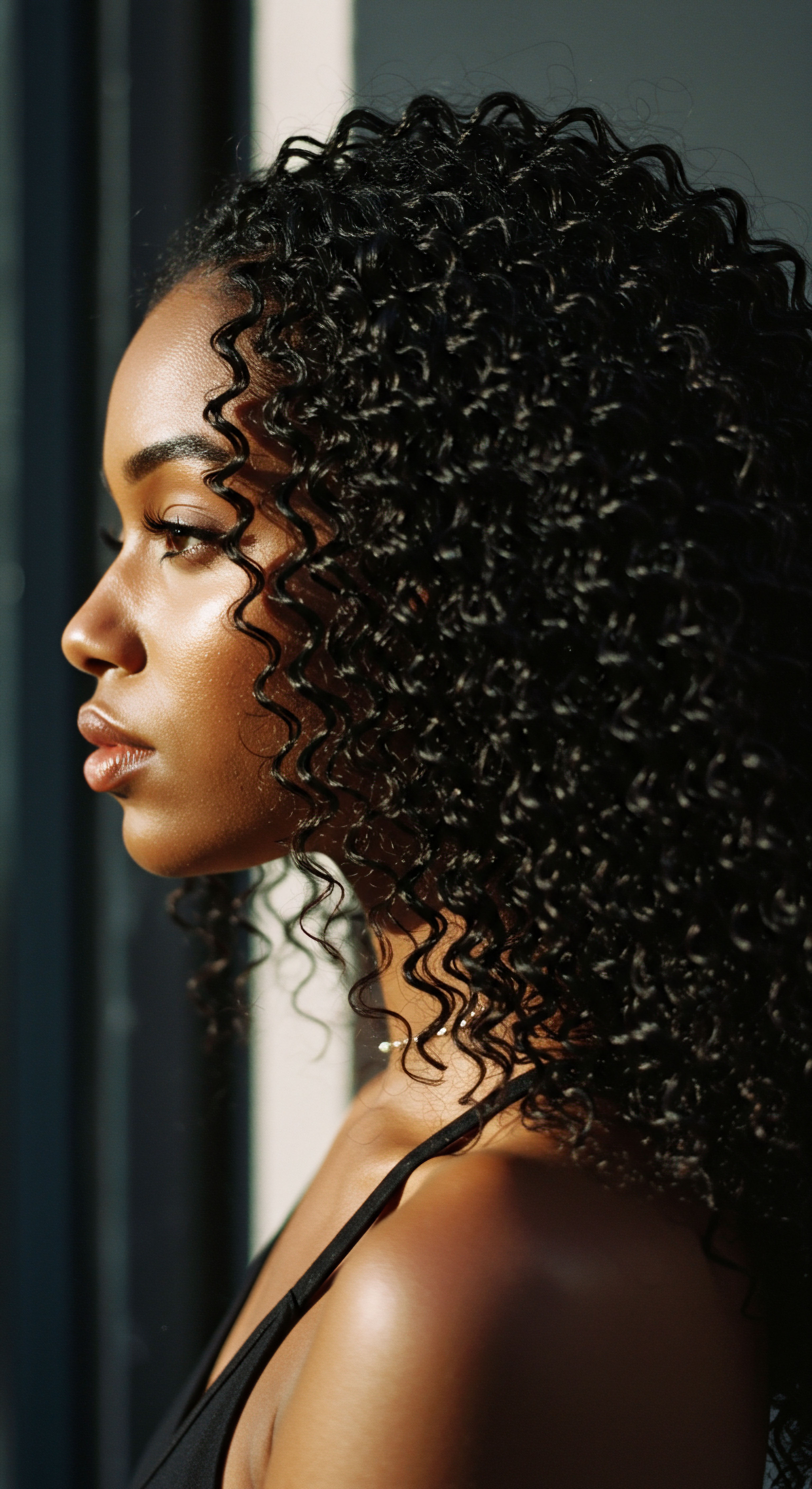
Roots
The quiet hours of night hold a particular power, a time when the world slows, and we seek solace in rest. For many with textured hair, this period is not simply for sleep; it becomes a deliberate act of care, a protective ritual. The choice to cover one’s hair with a bonnet before drifting off is deeply personal, yet it springs from universal truths about hair health, cultural practice, and the subtle mechanics of nightly movement.
This seemingly simple act carries layers of wisdom, passed down through generations and increasingly supported by an understanding of hair science. It speaks to a mindful approach to preserving the delicate beauty of curls, coils, and waves, ensuring they greet the morning with vitality rather than vulnerability.

The Intricacies of Textured Hair
Textured hair, with its remarkable diversity in curl patterns and densities, possesses a unique architecture. Unlike straight strands, which often present a more uniform, cylindrical shape, textured hair fibers can exhibit an elliptical or flattened cross-section, and their growth from the scalp occurs at varying angles. These structural characteristics contribute to the hair’s distinct appearance and feel, but they also influence its inherent qualities, such as its susceptibility to dryness and mechanical stress.
The helical shape of curls and coils naturally creates points where the cuticle, the hair’s outermost protective layer, may be slightly lifted. This natural configuration can lead to increased porosity, meaning the hair readily absorbs moisture from the air but also loses it just as quickly.
Consider the hair cuticle as a series of overlapping scales, much like shingles on a roof. In straight hair, these scales typically lie flat, creating a smooth surface that reflects light and reduces friction. For textured hair, the very nature of its bends and curves means these scales may not lie as uniformly flat, particularly at the points of curvature.
This subtle lifting allows moisture to escape more easily, contributing to a drier feel and a greater propensity for tangling and breakage. The journey of moisture through the hair shaft is a delicate balance, and any factor that disrupts this equilibrium can affect the hair’s overall condition and appearance.
Covering textured hair at night is a deliberate act of care, blending ancestral wisdom with modern scientific understanding for lasting hair vitality.

Hair Anatomy and Its Vulnerabilities
Understanding the physical structure of textured hair is key to appreciating why protective measures at night are so beneficial. Each strand comprises three main layers ❉ the medulla (innermost), the cortex (middle, providing strength and color), and the cuticle (outermost, protective). The cuticle, composed of dead, overlapping cells, plays a critical role in shielding the cortex from damage and regulating moisture content. When these cuticle scales are disrupted, either through environmental factors, styling practices, or mechanical abrasion, the hair becomes more susceptible to dehydration, frizz, and breakage.
The natural oils produced by the scalp, known as sebum, typically travel down the hair shaft to coat and protect the strands. On straight hair, sebum can distribute relatively easily. However, the coiled nature of textured hair can impede this downward flow, leaving sections of the hair, particularly the ends, less coated and thus more vulnerable to dryness. This inherent dryness, combined with the structural characteristics of the cuticle, means textured hair often requires external assistance to maintain its moisture balance and physical integrity, especially during periods of prolonged contact with surfaces, such as during sleep.
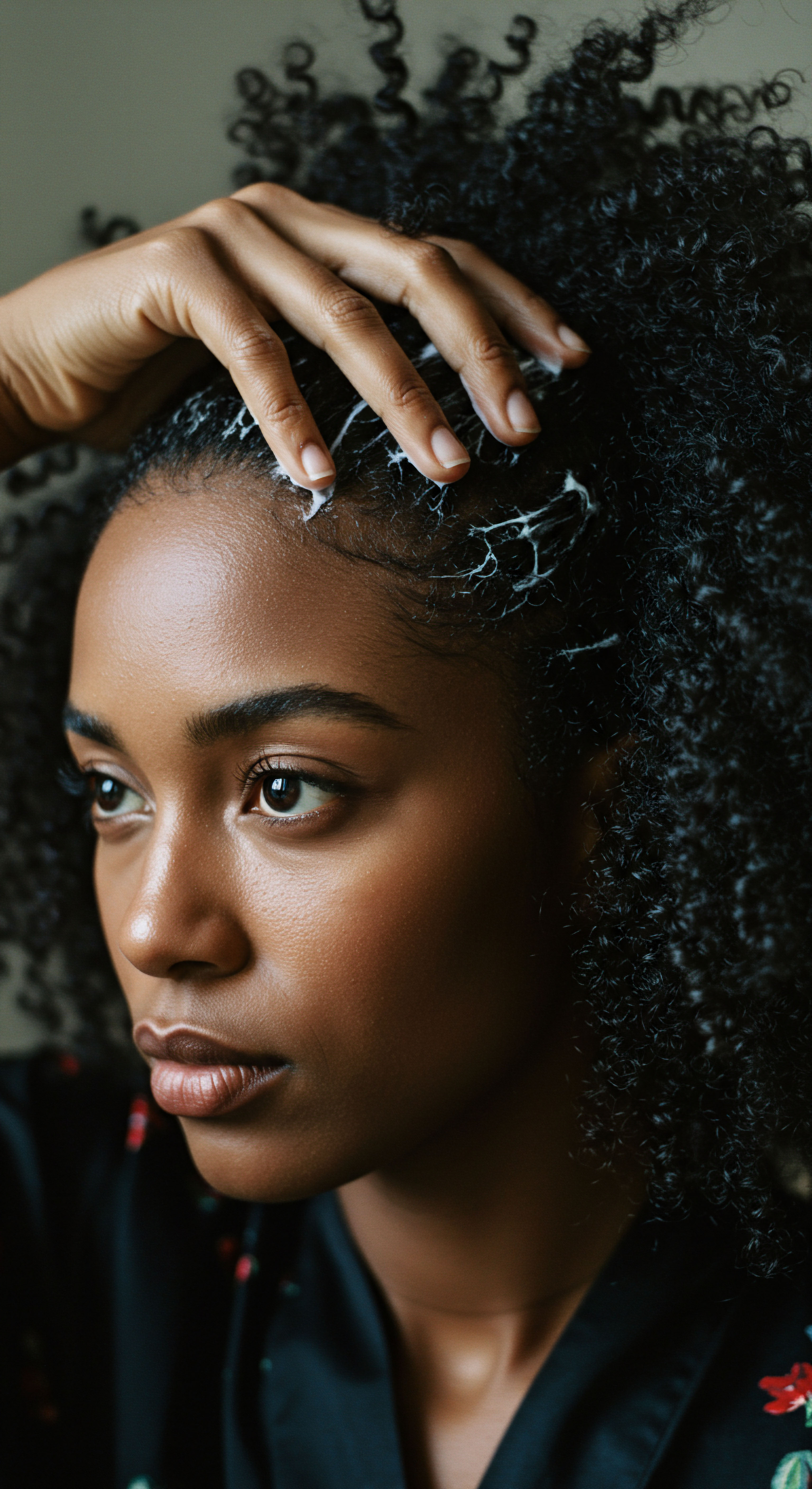
Understanding Hair Porosity
Hair Porosity describes the hair’s ability to absorb and retain moisture. It is a spectrum, from low to high, influenced by the cuticle’s condition.
- Low Porosity Hair ❉ Features tightly bound cuticle layers. This hair type tends to resist moisture absorption but, once hydrated, holds onto water well. Products may sit on the surface before absorbing.
- Medium Porosity Hair ❉ Presents a looser cuticle layer, allowing for balanced moisture absorption and retention. This hair type generally maintains good health and elasticity.
- High Porosity Hair ❉ Possesses cuticle layers that are raised or damaged, often due to chemical treatments, heat styling, or mechanical stress. This hair type quickly absorbs moisture but loses it just as rapidly, leading to dryness and frizz.
For textured hair, even without external damage, the natural configuration of curls can lead to areas of increased cuticle lift, contributing to what is often perceived as higher porosity. This characteristic makes the hair more prone to moisture loss, especially when exposed to drying environments or friction.
| Hair Component Cuticle |
| Description Outermost protective layer, overlapping scales. |
| Nighttime Impact Friction from pillows can lift scales, leading to damage. |
| Hair Component Cortex |
| Description Middle layer, providing strength and elasticity. |
| Nighttime Impact Compromised cuticle exposes cortex to moisture loss and breakage. |
| Hair Component Sebum Distribution |
| Description Natural oils from scalp, coats strands. |
| Nighttime Impact Coiled structure impedes even distribution, leaving ends dry. |
| Hair Component Porosity |
| Description Hair's ability to absorb and retain moisture. |
| Nighttime Impact Higher porosity means faster moisture loss during sleep. |
| Hair Component Understanding these elements highlights the need for nighttime protection for textured hair. |

Ritual
The soft rustle of a bonnet being donned signals a quiet dedication to hair well-being, a practical step in a daily routine. This simple act, often performed without much thought beyond its immediate purpose, speaks to a deeper understanding of hair’s needs. It moves beyond mere habit, transforming into a conscious ritual that protects and preserves. For those with textured hair, where every strand tells a story of unique formation and requires thoughtful care, the bonnet becomes a silent guardian through the night, a tangible expression of a commitment to hair health.
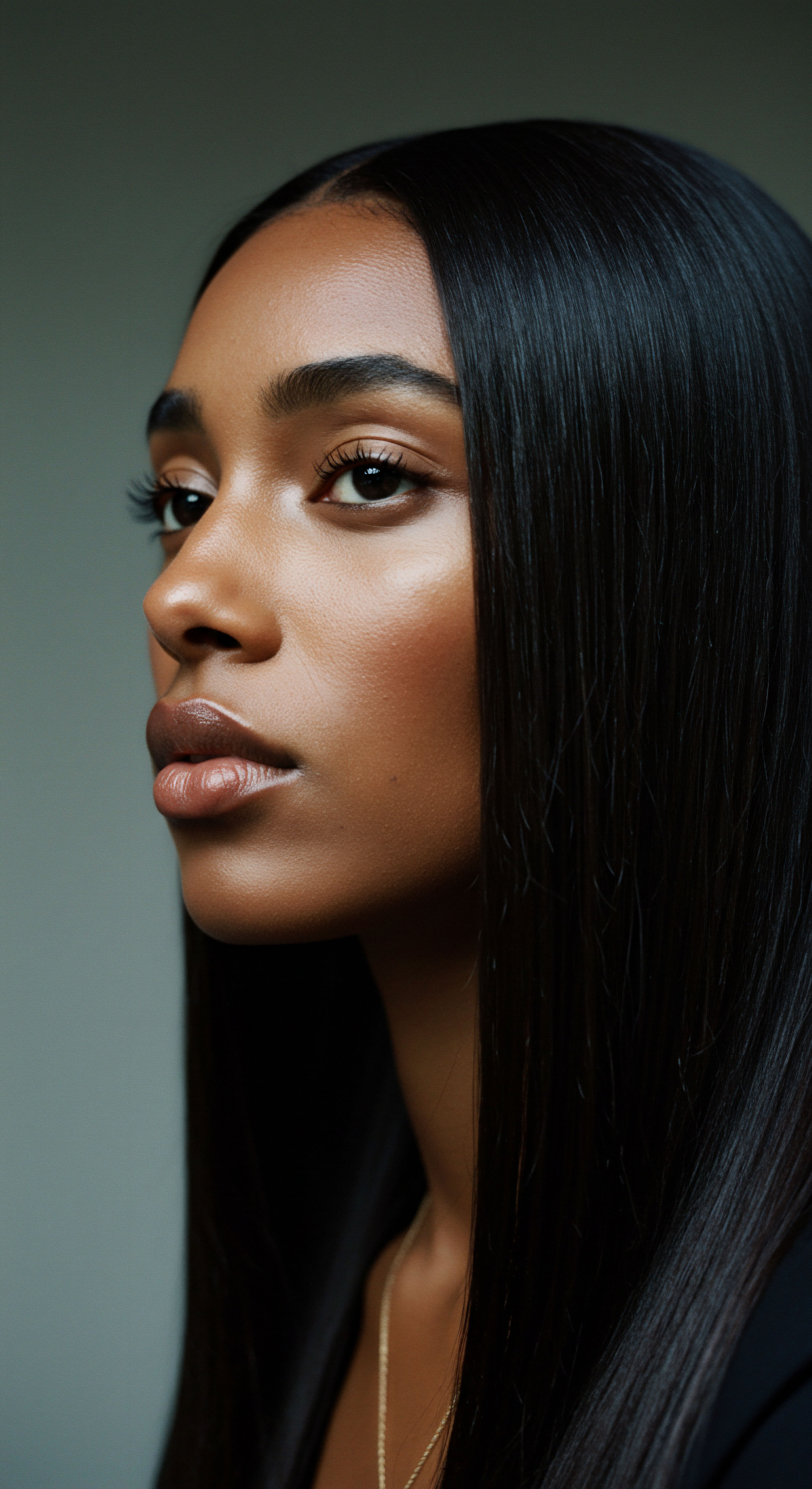
Why Do Bonnets Provide Protection at Night?
The primary purpose of wearing a bonnet at night is to create a protective barrier between textured hair and external elements, most notably the pillowcase. Traditional pillowcases, often made of cotton, can be quite abrasive to delicate hair strands. The fibers of cotton fabric possess a microscopic roughness that, when combined with the tossing and turning that occurs during sleep, creates friction.
This friction can lead to mechanical damage, causing the hair’s cuticle layers to lift, chip, or even break off. The result is often frizz, tangles, and split ends upon waking.
Moreover, cotton is a highly absorbent material. As it rests against the hair for several hours, it can draw out essential moisture and natural oils from the strands. This dehydration exacerbates the hair’s inherent dryness, leaving it feeling brittle and looking dull. A bonnet, typically crafted from smooth materials like satin or silk, offers a dramatically different interaction.
These fabrics have a low coefficient of friction, meaning hair glides over their surface rather than snagging or rubbing. This smoothness significantly reduces mechanical stress on the hair shaft.
Bonnets offer a smooth sanctuary for textured hair, minimizing friction and moisture loss during sleep.

The Science of Smoothness and Moisture Retention
The choice of material for a bonnet is not arbitrary; it is rooted in material science. Satin and silk are renowned for their smooth surfaces, which contrast sharply with the rougher texture of cotton. This difference in surface topography directly impacts the friction experienced by hair.
A study published in the Journal of Cosmetic Dermatology confirms that smoother fabrics, such as silk, assist in preventing hair shaft damage caused by repeated friction. This reduction in friction helps to keep the hair’s cuticle layers lying flat, preserving its integrity and natural sheen.
Beyond friction, the non-absorbent nature of satin and silk plays a crucial role in moisture preservation. Unlike cotton, which can absorb up to 27 times its weight in water, these smoother fabrics allow the hair to retain its natural hydration and any applied products, such as leave-in conditioners or oils. This sustained moisture content keeps the hair supple, elastic, and less prone to breakage. The maintenance of proper moisture levels is particularly vital for textured hair, which is often predisposed to dryness due to its structure and the slower distribution of natural scalp oils.
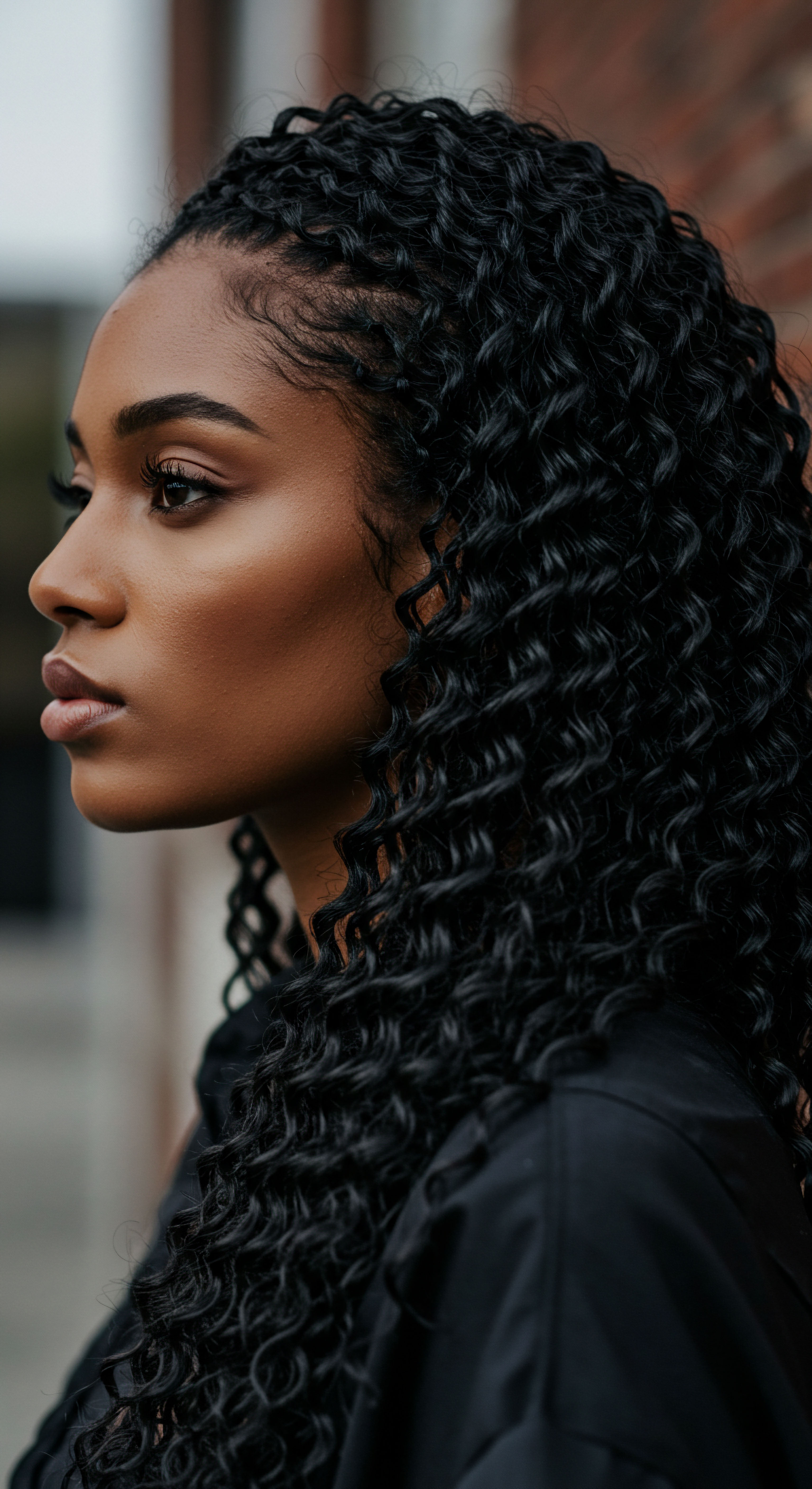
Practical Benefits of Nighttime Hair Covering
The tangible benefits of incorporating a bonnet into a nightly routine extend beyond scientific principles, translating into noticeable improvements in hair health and manageability.
- Minimized Breakage ❉ Bonnets shield hair from friction against bedding, which is a leading cause of mechanical damage and breakage, particularly for delicate textured strands.
- Reduced Frizz ❉ By preventing cuticle disruption and maintaining moisture, bonnets help keep the hair’s natural curl pattern defined and smooth, significantly cutting down on morning frizz.
- Preserved Styles ❉ Whether it’s a fresh wash-and-go, braids, twists, or a blowout, bonnets help to maintain the integrity of hairstyles, extending their longevity and reducing the need for daily restyling.
- Retained Moisture ❉ The non-absorbent qualities of satin and silk keep hair hydrated, allowing natural oils and applied products to stay on the hair, rather than being absorbed by the pillowcase.
- Less Tangles ❉ Hair is less likely to become matted or tangled when contained within a bonnet, making detangling in the morning easier and less damaging.
| Material Cotton |
| Surface Texture Rough, fibrous |
| Moisture Absorption High |
| Friction Level High |
| Impact on Hair Causes frizz, breakage, dryness |
| Material Satin/Silk |
| Surface Texture Smooth, slick |
| Moisture Absorption Low |
| Friction Level Low |
| Impact on Hair Reduces frizz, breakage, retains moisture |
| Material The choice of fabric significantly alters nighttime hair protection outcomes. |
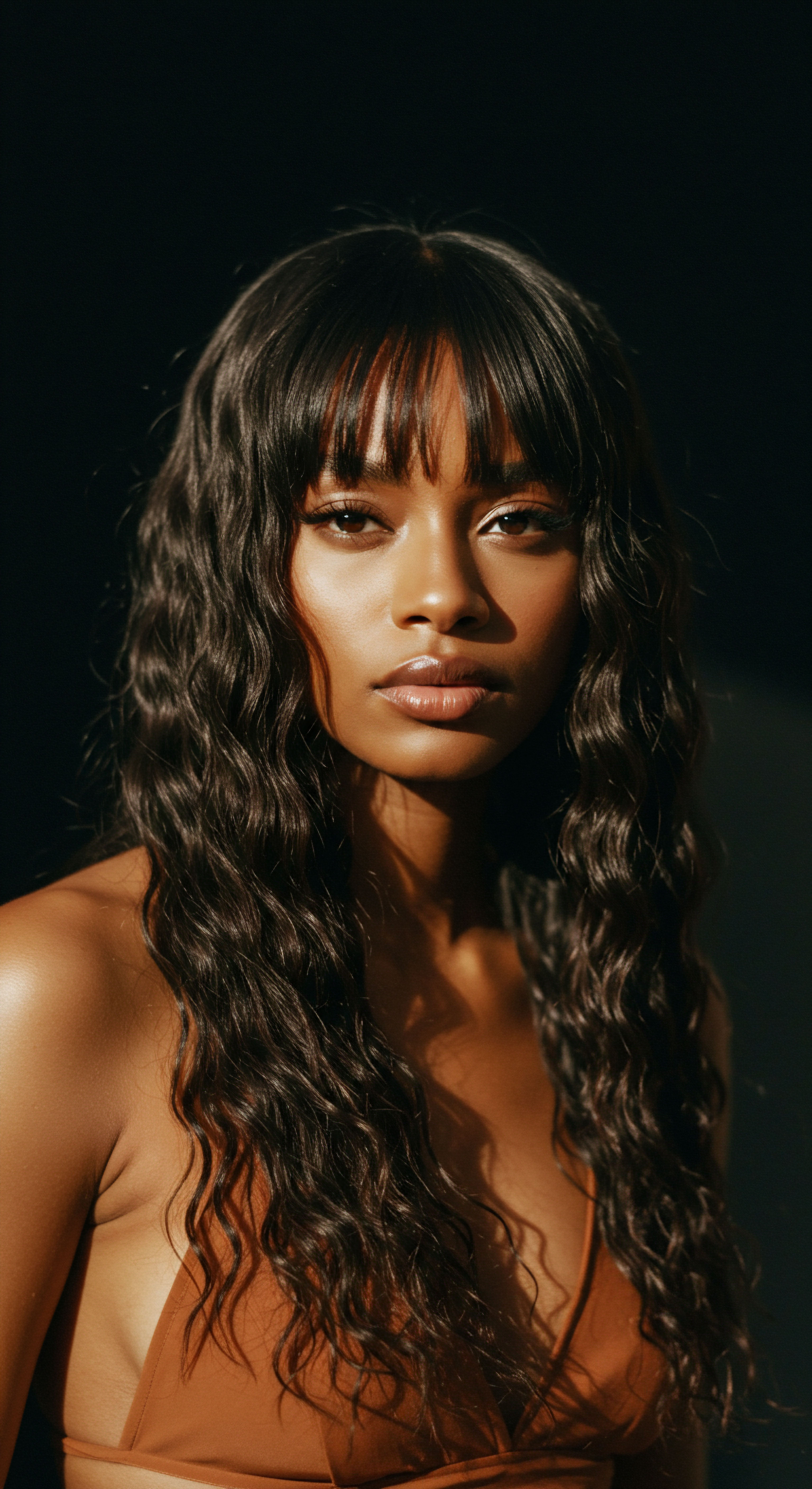
Relay
Beyond the tangible benefits and practical applications, the use of bonnets at night for textured hair reaches into deeper cultural currents and scientific understandings, revealing layers of meaning that extend beyond simple hair care. It beckons us to consider how tradition, scientific inquiry, and personal identity intersect in a practice that has long been a quiet, yet powerful, element within certain communities. This exploration moves past surface-level observations, seeking to connect the dots between ancestral wisdom, modern research, and the broader context of hair as a marker of identity and resilience.

Cultural Significance of Head Coverings
The act of covering one’s hair, particularly within Black and mixed-race communities, carries a rich historical and cultural weight that predates modern hair science. Head coverings, including forms that resemble contemporary bonnets, have served multiple purposes across the African diaspora for centuries. Historically, these coverings were not solely for practical protection; they signified social status, marital status, religious adherence, and tribal affiliation.
During periods of enslavement, head coverings became a means of forced conformity, but they were simultaneously transformed into symbols of resistance and identity. Enslaved women would wear their wraps in ways that conveyed hidden messages or maintained a connection to their heritage.
This legacy of hair covering as a form of protection, self-expression, and cultural continuity persists. While the bonnet’s primary function today may be hair health, its presence in nightly routines for many with textured hair subtly echoes this deep cultural lineage. It represents a continuity of care and a quiet assertion of identity, preserving a part of self that has historically been scrutinized and, at times, policed. The practice carries an unspoken acknowledgment of the unique needs of textured hair, needs that have been understood and addressed within communities long before mainstream science began to investigate them with earnest attention.

Does Modern Science Validate Traditional Practices?
For generations, the efficacy of using smooth fabrics for hair protection has been a matter of anecdotal evidence and lived experience within textured hair communities. Only relatively recently has mainstream hair science begun to catch up, offering empirical validation for what has long been known. This historical gap in research, where textured hair received less scientific attention compared to other hair types, is a noteworthy point.
Until recently, a disproportionately small percentage of dermatological and cosmetic science research focused specifically on the unique structural and physiological characteristics of Black and mixed-race hair. This oversight meant that practices, such as bonnet use, were sustained by community knowledge rather than widely published scientific literature.
However, a growing body of research now substantiates the benefits. Studies on the tribological properties of hair and textiles consistently demonstrate that smoother fabrics, like silk and satin, significantly reduce friction compared to rougher materials like cotton. This reduction in friction is paramount for textured hair, as its coiled structure makes it more prone to mechanical damage from rubbing.
For instance, a study investigating friction between hair and different textile materials found that sliding cotton against hair resulted in higher friction than polyester, while nylon showed the lowest friction. While this particular study focused on different synthetic textiles, the principle holds true for the comparison of cotton versus silk/satin on hair ❉ lower friction means less cuticle damage.
Furthermore, the role of moisture retention is increasingly supported. Cotton’s absorbent nature can deplete hair of its natural oils and hydration, leading to dryness and breakage. Conversely, silk and satin do not absorb moisture from the hair, allowing strands to remain hydrated overnight.
This is particularly critical for textured hair, which is inherently more prone to dryness due to the slower distribution of sebum along its coiled structure. The science confirms that practices minimizing friction and preserving moisture directly address the primary vulnerabilities of textured hair.

The Microscopic Reality of Nighttime Damage
To truly appreciate the bonnet’s protective role, one might consider the microscopic world of the hair shaft during sleep. The hair cuticle, a layer of overlapping scales, is the first line of defense. When hair rubs against a cotton pillowcase, these scales can lift, chip, or even be removed. This process, often described as cuticle abrasion, weakens the hair strand, making it susceptible to further damage, including split ends and breakage along the shaft.
Consider a specific, less commonly discussed aspect ❉ the potential for Electrostatic Charge build-up. Hair, being a good insulator, can develop electrostatic charge when rubbed against certain textiles, particularly in dry environments. This charge can cause strands to repel each other, leading to increased frizz and tangles, making hair more difficult to manage and further susceptible to mechanical damage during detangling. Smooth fabrics like silk and satin, due to their composition and lower friction, are less likely to generate significant electrostatic charge, thus contributing to smoother, more cohesive strands upon waking.
This phenomenon, while perhaps not as widely cited as friction or moisture loss, plays a subtle yet meaningful role in maintaining hair integrity. A study on the triboelectrification of textiles noted that hair develops electrostatic charge when rubbed with human skin, plastic, and textiles. The smoother the fabric, the less static charge generated. This adds another layer of scientific backing to the traditional wisdom of choosing slick, non-cotton fabrics for nighttime hair protection.

What are the Long-Term Implications of Consistent Nighttime Hair Protection?
Consistent use of bonnets or similar satin/silk coverings can lead to measurable improvements in textured hair health over time. Reduced breakage means greater length retention, allowing individuals to achieve their desired hair length more easily. Less frizz translates to more defined curl patterns and a healthier overall appearance. The sustained hydration supports elasticity, making the hair more resilient to styling and environmental stressors.
Beyond the physical aspects, there is a psychological component. The act of caring for one’s hair, seeing it respond positively to consistent protective measures, can contribute to a sense of self-efficacy and satisfaction. It reinforces a positive relationship with one’s natural hair texture, moving away from narratives of “managing” unruly hair towards celebrating its unique characteristics. This self-care ritual, steeped in both historical precedent and scientific validation, becomes a quiet affirmation of personal well-being and cultural connection.
| Aspect Friction Reduction |
| Scientific Principle Smooth fabrics (satin/silk) reduce mechanical abrasion on cuticle. |
| Cultural Context Historical use of headwraps for protection during labor. |
| Aspect Moisture Retention |
| Scientific Principle Non-absorbent fabrics keep hair hydrated. |
| Cultural Context Recognition of textured hair's dryness predisposition. |
| Aspect Breakage Prevention |
| Scientific Principle Reduced friction and maintained hydration strengthen strands. |
| Cultural Context Long-standing community knowledge of hair vulnerability. |
| Aspect Static Control |
| Scientific Principle Smooth surfaces minimize electrostatic charge build-up. |
| Cultural Context Traditional methods for maintaining hair cohesion and definition. |
| Aspect Identity & Self-Care |
| Scientific Principle Psychological benefits of visible hair health. |
| Cultural Context Head coverings as symbols of resilience and heritage. |
| Aspect Bonnets are a convergence of scientific understanding and enduring cultural practices. |

Reflection
The quiet nightly gesture of covering one’s hair with a bonnet reveals itself as far more than a simple habit. It is a thoughtful conversation between heritage and modernity, between personal care and collective wisdom. This practice, so often observed yet perhaps not fully understood by all, stands as a gentle affirmation of textured hair’s unique character and needs.
It speaks to a deep, abiding respect for strands that require a particular kind of guardianship, a quiet commitment to preserving their vitality and inherent splendor. As we continue to learn more about the science of hair and the enduring stories woven into our daily lives, the bonnet remains a soft, protective embrace, a testament to thoughtful care that truly lasts.

References
- Davis-Sivasothy, Audrey. The Science of Black Hair ❉ A Comprehensive Guide to Textured Hair Care. Sivasothy Hair, 2011.
- Lyu, Jingchun, et al. “Role of Hair Coverage and Sweating for Textile Friction on the Forearm.” Tribology Letters, vol. 68, no. 4, 2020, p. 100.
- Robinson, Vivian. “The effect of grooming on the hair cuticle.” ResearchGate, 2019.
- Ali, W. Y. “Reducing the electrostatic discharge generated from the contact and separation as well as sliding of polymeric textiles on cotton.” Journal of the Egyptian Society of Tribology, vol. 10, no. 2, 2013, pp. 45-56.
- Aguh, Crystal, and Ginette Okoye. Fundamentals of Ethnic Hair ❉ The Practical Guide to Hair Care for Patients of Color. Springer, 2017. (General reference for textured hair science)
- Robbins, Clarence R. Chemical and Physical Behavior of Human Hair. 5th ed. Springer, 2012. (General reference for hair science and properties)
- Feughelman, Max. Mechanical Properties of Wool Fibres and Yarns. CSIRO Publishing, 1997. (General reference for fiber mechanics)
- Gavazzoni, Cristina, et al. “Hair Breakage ❉ Causes, Diagnosis, and Treatment.” Journal of Cosmetic Dermatology, vol. 18, no. 4, 2019, pp. 958-964. (General reference for hair damage)
- Lee, Eunice, et al. “An Overview on Hair Porosity.” NYSCC, 11 Nov. 2020.
- Pfeiffer, C. et al. “Porosity and Resistance of Textured Hair ❉ Assessing Chemical and Physical Damage Under Consumer-Relevant Conditions.” MDPI, vol. 11, no. 8, 2022, p. 1475.